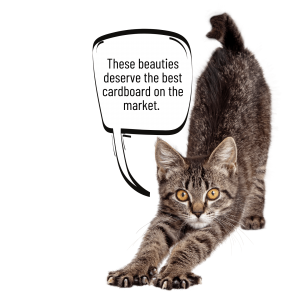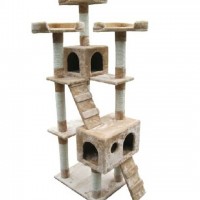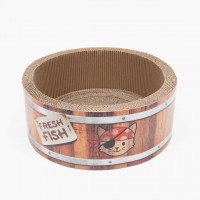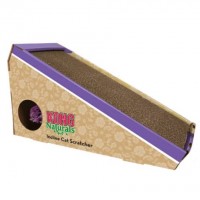Select a topic to learn more
All Paws Need Claws
Why paws need claws
 Claws are commonly known to be useful to cats for hunting, climbing and self-defence. They have several other less obvious but equally important uses, too.
Claws are commonly known to be useful to cats for hunting, climbing and self-defence. They have several other less obvious but equally important uses, too.
Stretching
When you see your cat grab hold of the scratching post and do that big arched back stretch with a satisfying yawn, his claws are what allow him to do it. Have you ever noticed that your cat tends to scratch surfaces in close proximity to his favourite nap spot? It’s because, just like us, he wants to have a big ol’ stretch before he starts his day again for the 5th time. You’d probably earn extra “Beans” from him by placing a scratching post next to his bed.
Scratching
Cats have some very important and personal reasons for scratching. It’s one of the effective ways to mark their territory. Even within happily managed multi-cat households, the cats are sending each other very subtle signals to say “what’s going on.” They will use their paw pads and claws to mark a surface with pheromones and, as a visual marker, to remind the other cats in the household. This doesn’t mean the cats aren’t getting along and can in fact play an important role in keeping the peace!
There are two other significant and personal motives cats scratch. The act of scratching removes the worn layers of their claws and sharpens the fresh ones (nail trims are covered soon) and it also serves to maintain healthy claw motion so they’re always ready when needed.
Playing
Cats love to mimic hunting as a form of play. It’s really satisfying for them to dig their front claws into their “prey” and use the back ones when kicking it senseless. It can actually be frustrating if they don’t get to have this satisfaction at least once during a stalk-and-chase game. If your cat loves to chase the flying red dot, earn some more “Beans” with him by giving him a catnip-filled stuffy to grab onto at the end of the play session.
Encourage appropriate scratching behaviour
We get what we want from dogs because they are eager to please us; we can get what we want from cats if we’re eager to please them. Dr. Amy (link to profile) professes that, “Cats always win. Always.” When we accept this truth, the keys to directing their behaviours become clearer.
Cats respond to positive reinforcement
The most important thing to understand is that cats respond to positive reinforcement. Punishment usually leads to the opposite effect people hope for – it leads to worsening or new undesirable behaviours. When a cat uses his intended scratching surface, reinforce this behaviour by putting a little catnip on down, or giving him a treat and some gentle pets. If he’s caught scratching furniture or that nice new rug in the master bedroom, gently pick him up and take him to his nearest intended scratching surface and then give him a treat when he starts to use it. No water bottles needed!
Give your cat his own personal scratching surfaces
Another way to please our cats and get them scratching what they should is by providing them what they want to scratch! Some cats prefer one surface type over another and some cats love it all! It’s absolutely worth starting with a variety of textures such as sisal rope, carpet and corrugated cardboard, and also a variety of ways to use them. Scratching surfaces can be vertical, horizontal or diagonal, or they can hang from door knobs or lay flat on the window ledge. A cat that is already scratching inappropriately is giving his owner very good hints about what he likes best.
Adorn your cat with a mani-pedi session
 If two best friends can bond over having their nails done, so can a cat and his human…just not at a salon, ideally. A cat in the wild will naturally wear his own claws down because he’s constantly on the move, so our domestic pals need a little help from us to keep their own in check. It’s important to them because overgrown claws can curl and pierce the paw pad (OUCH) and also make it difficult to do their favourite activities. A cat may be resistant to claw trims, especially if already attempted several times without success. It’s easiest to start them off as kittens but there are a few things you can do to make the process better for everyone.
If two best friends can bond over having their nails done, so can a cat and his human…just not at a salon, ideally. A cat in the wild will naturally wear his own claws down because he’s constantly on the move, so our domestic pals need a little help from us to keep their own in check. It’s important to them because overgrown claws can curl and pierce the paw pad (OUCH) and also make it difficult to do their favourite activities. A cat may be resistant to claw trims, especially if already attempted several times without success. It’s easiest to start them off as kittens but there are a few things you can do to make the process better for everyone.
How to make nail trims easier
Creating a positive atmosphere around you and your cat at claw trim time is critical. Find a quiet time when you won’t be interrupted and your cat is awake and relaxed. Let him see and smell the clippers and give him a treat and pets while he investigates. If he’s wiggly, you can use the “burrito” method and wrap him in a towel or blanket. Even better, apply synthetic pheromones to the towel or blanket 10 minutes before wrapping him. Do your best to stay calm and keep your voice pleasant throughout because cats are super sensitive to their human’s feelings and behaviour. After finishing each paw, give him a treat and let him know how wonderful he is. The mani-pedi sessions with your feline bestie will get easier over time if the experience is positive and kept up on a regular basis.






 Start with a huge, uncovered box, or even a kiddie pool, and fill with a thick layer (about 6 inches) of unscented clay or fine sand-like particulate clumping/scoopable litter. For Ollie, you may need to play around with the substrate types to make it more natural. Try using soil or peat.
Start with a huge, uncovered box, or even a kiddie pool, and fill with a thick layer (about 6 inches) of unscented clay or fine sand-like particulate clumping/scoopable litter. For Ollie, you may need to play around with the substrate types to make it more natural. Try using soil or peat.